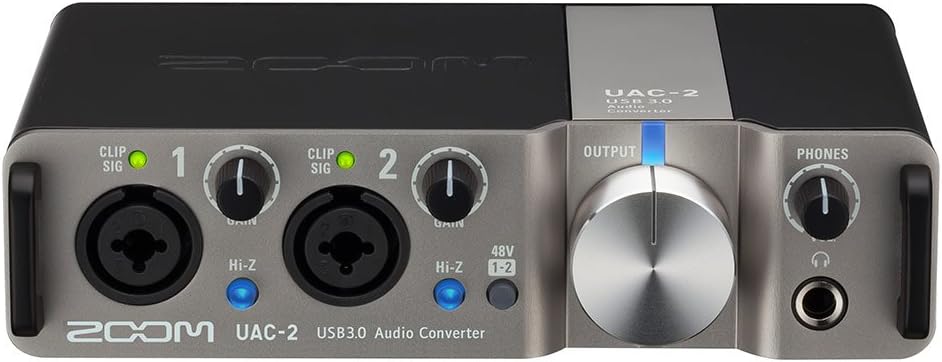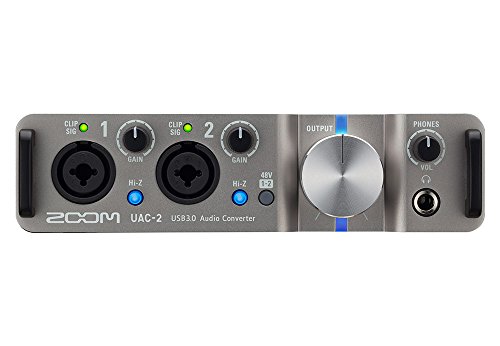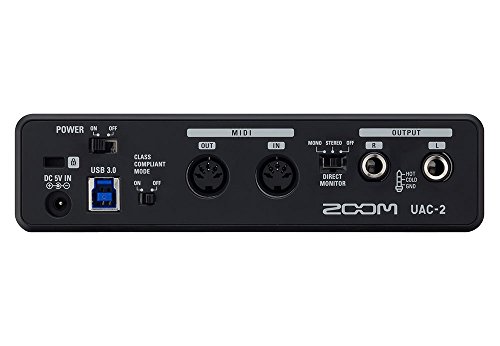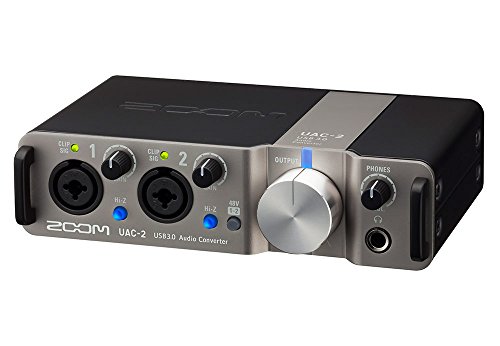Introduction
The Zoom UAC-2 is a compact and versatile audio interface designed to elevate your recording experience. Let’s delve into its features, benefits, drawbacks, and overall performance.
Design and Build
- Robust metal chassis for durability
- Compact size for portability
- Convenient layout of controls for easy access
The UAC-2 is built strong to stay dependable when moved around, and its smart design makes it easy to adjust controls, which is great for musicians and producers who work while traveling.
Connectivity
- Two combo XLR/TRS inputs
- MIDI I/O ports
- 1/4″ headphone output
- USB 3.0 connectivity
The UAC-2 has many ways to connect and works fast with USB 3.0. It easily links to different devices like instruments and audio sources, making it useful for a lot of things.
Audio Quality
- 24-bit/192kHz resolution
- Ultra-low latency
- High-quality preamps
The UAC-2’s impressive audio resolution and low latency ensure pristine sound capture, providing musicians and audio engineers with professional-grade recordings.
Pros
- Sturdy build ideal for travel
- Versatile connectivity options
- High-resolution audio quality
- Low latency ensures real-time recording
Cons
- Lack of dedicated gain controls for individual inputs
- Limited simultaneous recording channels
Conclusion
In summary, the Zoom UAC-2 is a trustworthy and small audio device perfect for musicians and producers who want top-notch recordings while traveling. Although it has some small issues, its strong design, many connection options, and excellent sound make it a great tool for any recording setup.





Daniel –
When I got the product i did not have a laptop speedy enough to be compatible. I kept this audio interface packed for a long time. This was bcause all the products i bought on amazon were up to the mark. When I got a laptop with windows 11, this interface did not work. I knew that the warranty period had passed so I tried the market to get it repaired. They say that some I C is not working and not available too. Such a waste of my hard earned money. I request the seller to at least get it repaired. I will bear the cost of repair and couriers.
Prathmesh Mudholkar –
Its my first every sound card. Love it. The first installation needs to be done using the usb 2.0 port. It may be ok with 3.0 port as well(I dont have one), but certainly problematic with USB 3.1 port. After first installation using port 2.0, i am able to use it with 3.1 port as well. I spent precious hours experimenting to find this out. Hope it helps someone.
Fornaio –
I needed a new audio interface for recording vocals since my old USB 1.0 interface has serious compatibility problems with my new X99 motherboard that I was unable to resolve. I use Zoom field recorders that have served me well, so I decided to give this one as a try. Very simple PC setup:
Shure SM58 mic to XLR jack on UAC-2
Monitoring with headphones on “Phones” jack on UAC-2
USB 3.0 port on PC
Windows 10 Pro
Zoom UAC-2 ASIO Driver at maximum sample rate
Ableton Live 9
The MixFx application that launches automatically when you connect the UAC-2 works fine, but doesn’t really provide anything I need for my simple setup. It is supposed to alert if new firmware is available for the UAC-2 so I usually keep it running.
Signal quality and low-latency perfectly meet my needs as an aspiring musician.
harshvardhan verma –
No issue with win 7/64, win 10/64. Latency is almost negligible. I have no mac book. So I can not tell. But I use Jam origin Midi guitar with iPad. To work with iPad it requires an external zoom power adapter. And that is a costly and rare item. It would be better to get the adapter in the packet with the price slightly increased.
Fiddleback –
Bought the UAC-2 11 months ago. Beautiful sound, great latency, whisper quiet.
6 months ago the channel 2 gain control started randomly changing levels and became unresponsive to any front panel knob adjustment — the gain would just max out and sit there. The only way to adjust it was using the mixfx software but it would not keep the adjustment. Then, last month the exact same thing happened to gain control on channel 1. It’s now unusable in any way.
Which is terrible because it sounded so, so good on my system.
Karl Calixto –
Superb Build Quality ✅
Very Good Pre Amp ✅
No Driver Issues (Used on W10-11) ✅
3.0 is amazing ✅
Does Good Translation in DA Conversation [Monitoring]
Darin –
The product didn’t take long to set up and, after setting up, was wonderful. Almost zero latency, great sound, very clear. BUT, after about 3 months it has failed to be recognized by my DAW, drum software, and the ASIO won’t be found by Windows 10. I’ve done all the recommended solutions (re-load, well, everything and more) but to no avail. I wrote to Amazon to return it as it has a one-year warranty and they said ‘go to Zoom’. Zoom says ‘go to your seller, Amazon’. So, now I’m stuck with a brick and still trying to figure out how to return it for a new one.
I can only rate this based on my experience, which was excellent and is now zero, as it won’t work. If I could get it returned, I’d rate it a 3 (5 for the sound, 1 for the lack of support = 3).
Ted Ashburn –
DAC Conversion is great. Driver is rock solid. The preamps maybe not as good as my focusrite Forte. But the latency is incredibly low and I’m satisfied with the audio quality and features. It’s the only small, affordable USB 3.0 interface that Im aware of. Haven’t tested with windows 10 yet. But works great on Win 8.1
Sami S –
I bought this to record guitar with garageband. The previous solution i was using had a continuous hum when I connected the guitar. More annoying was the noticeable delay between playing and hearing it back through the computer. With the Zoom UAC-2 I don’t have any static noise at all and zero delay while playing. I definitely recommend it.
Karl Calixto –
So worth the money! I don’t go for low budget stuff because I see everything I have as an investment, and I have to say I’m happy with this 250 dollar interface. Of course you can find some that have additional options for 500 more, but trust me: this baby does the job and it’s good!
Xprod77 –
First let me qualify this review with my PC setup as most reviews will almost always eventually lead to “what kind of setup do you have” questions: I’m running a custom build Intel Hex-core i7-5820 overclocked to 4.2ghz, EVGA X99 Micro 2 MOBO, 32GB Corsair XMS DDR4, EVGA GTX950 video card, Samsung 256GB NVME SSD, Mushkin 1TB Reactor storage SSD, and WIn 10 64 Pro all in a liquid-cooled Corsair Air 240. This is NOT a “studio-only” PC. I use this PC for everything; email, surfing the net, Photoshop, video editing, telecommuting for work, etc. I know many people are VERY strict (anal) about not using their studio PC for anything but that but I have found after decades of building PCs that it’s really not that big of a deal. I’ve seldom had any conflicts or performance hits due to also running software other than whatever DAW I was using. Lastly, you should know that my aim with this purchase was mainly focused on LATENCY. I’ve streamlined my home setup (kids will do that) so that I’m basically doing everything with VSTs/virtual instruments now. That means I need the lowest latency I can get to get a natural feel when tracking.
Prior to this Zoom I was using an aging Mbox 2 with Pro Tools 11. I have since (finally) left the Pro Tools camp after over 15 years of far too many upgrades/crossgrades and over-charged nonsense. I have only recently begun to use Presonus Studio One. Running my Mbox 2 through Studio One would cap at a buffer of 128/44k and anything lower would seriously distort the signal. Some research showed that this is a known issue with the Mbox 2 on Windows 10 64. With that buffer setting I was getting noticeable latency. Presonus was reporting something like 10ms input and 10ms output. I’ve read that still wouldn’t be the true real-time latency (RTL) number that ultimately matters (it would be higher) so that wasn’t good at all. Especially since I couldn’t get the buffer down any lower. After countless hours of research, mostly on Gearslutz and DAW Bench, it seemed that I either needed to drop serious money on an RME device or wait until the situation gets better with all the other brands. Well, I got kids…and RME wasn’t going to fly with the wife. So that left me kind of stuck…I could get a firewire card and try out the Focusrite Saffire Pro series but I didn’t feel like adding more PCI cards to my setup and some reviews were mixed on it. What was key in my research was this…it’s not so much the interface hardware as much as the DRIVERS that matter. Apparently there are very few interface makers that actually develop their own drivers. RME, of course, is one of them and that’s why they are always at the top of the list of low-latency interfaces. Most use the same generic driver that may or may not be fully optimized for the interface. So on one of my research binges I noticed some forum posters on Gearslutz mentioning ZOOM this and ZOOM that. Now, I’m primarily a guitar player and I had heard of Zoom before from way back in the day and my initial impression back then was basically that they were the Walmart of guitar products. Cheap, made-in-China, knockoff and low quality stuff that I would NEVER put on my pedal board. So as I’m reading some users raving on the quality and most importantly, the low latency of the UAC-2, I was skeptical. There were even some comments about Zoom supposedly contracting a company solely for the purpose of developing their own drivers for this product and the theory being that THAT is why the latency was so good on this device. That’s how I ended up here. For $250 (vs. $750 for the RME Babyface Pro) it was a no brainer to check this one out. I’m very glad I did. I’m getting incredible latency numbers being reported by Presonus and most importantly, I can’t detect any delay when I’m tracking guitar loaded with amp sims and effects or synth VSTs. It’s amazing. Presonus is reporting something around 1.54 input latency and 4.04 output latency with a 64 buffer at 44k.. And again, yes I know that is not the true RTL number, but it sure is better than what my mbox was able to achieve and it’s noticeable to my ears and playing.
Lastly, the install was ultra smooth. I did not experience any issues installing the latest drivers or setting it up in Presonus Studio One. To summarize, if latency matters to the kind of work you’re doing with your DAW, it’s hard to beat the value this unit represents. FIVE stars.
Adastra –
Great sound, and easy to set up and use.
One oddity is that XLR plugs have better connectivity than TRS plugs in the two front input jacks. If I use TRS plugs I have to jiggle a bit to get a good input connection.
sudipto paladhi –
Las reseñas se quedaron cortas, la interfaz se lleva de calle al resto, no sé si el cambio a 3.0 sea la clave pero fuera de lo que hables no entran regalos jeje no hay ni un leve de gis y con los fierros adecuados vas a lograr un audio destacado.